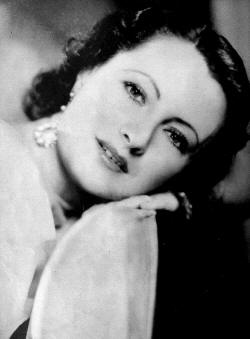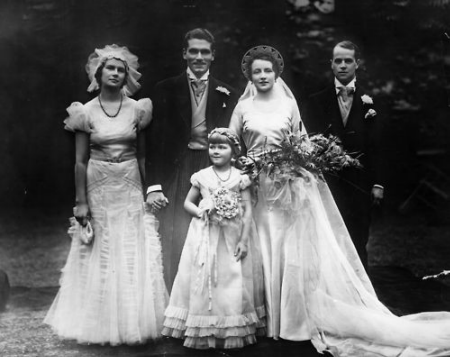Husband
Laurence Olivier
Queer Places:
74 Cheyne Walk, Chelsea, London SW3 5TT, Regno Unito
Garden of Allah, 8152 Sunset Blvd, Los Angeles, CA 90046
Abney Park Cemetery
Stoke Newington, London Borough of Hackney, Greater London, England
 Jill Esmond (born Jill Esmond Moore; 26 January 1908 – 28 July 1990) was an English stage and screen actress. She was the first wife of Laurence Olivier. Legend has it that both Jill and Laurence regretted their marriage just weeks after the ceremony, but it wasn’t until the couple’s dual performance in the Broadway hit The Green Bay Tree that really saw the beginning of the end of their marriage. The play featured multiple gay characters and a former lover of Jill’s,
Phyllis Konstam, would later say, “Night after night they were speaking lines and creating characters that mirrored their own private lives. She preferred women to men. He was, at the very least, bisexual. They must have known that the marriage could never last.” Despite putting on a happy face for the public, Jill and Laurence’s marriage was deeply unhappy and riddled with extramarital affairs. With the birth of her son Tarquin in 1936 and her inevitable divorce from Laurence in 1940, Jill’s acting career became sporadic. She had begun to turn down roles that her husband disapproved of, which were many, and by the time they had separated it was too late to reclaim her former stardom. Jill’s very last acting role was as Eleanor of Aquitaine in the 1955 television series The Adventures of Robin Hood. Despite the barrage of bad press and celebrity gossip that followed her divorce and Laurence’s subsequent Hollywood affairs, Jill remained on good terms with her ex-husband for the rest of his life and was in attendance at his 1989 funeral.
Jill Esmond (born Jill Esmond Moore; 26 January 1908 – 28 July 1990) was an English stage and screen actress. She was the first wife of Laurence Olivier. Legend has it that both Jill and Laurence regretted their marriage just weeks after the ceremony, but it wasn’t until the couple’s dual performance in the Broadway hit The Green Bay Tree that really saw the beginning of the end of their marriage. The play featured multiple gay characters and a former lover of Jill’s,
Phyllis Konstam, would later say, “Night after night they were speaking lines and creating characters that mirrored their own private lives. She preferred women to men. He was, at the very least, bisexual. They must have known that the marriage could never last.” Despite putting on a happy face for the public, Jill and Laurence’s marriage was deeply unhappy and riddled with extramarital affairs. With the birth of her son Tarquin in 1936 and her inevitable divorce from Laurence in 1940, Jill’s acting career became sporadic. She had begun to turn down roles that her husband disapproved of, which were many, and by the time they had separated it was too late to reclaim her former stardom. Jill’s very last acting role was as Eleanor of Aquitaine in the 1955 television series The Adventures of Robin Hood. Despite the barrage of bad press and celebrity gossip that followed her divorce and Laurence’s subsequent Hollywood affairs, Jill remained on good terms with her ex-husband for the rest of his life and was in attendance at his 1989 funeral.
Esmond was born in London, the daughter of stage actors Henry V. Esmond and Eva Moore.[1] Dramatist W.S. Gilbert and actress Maxine Elliott were her godparents.[2]
While her parents toured with theatre companies, Esmond spent her childhood in boarding schools until she decided at the age of 14 to become an actress. She made her stage debut playing Wendy to Gladys Cooper's Peter Pan, but her success was short-lived. When her father died suddenly in 1922, Esmond returned to school and at the time considered abandoning her ambition to act.
After reassessing her future and coming to terms with her father's death, she studied with the Royal Academy of Dramatic Art in London, and returned to the West End stage in 1924. In 1925, she starred with her mother in a play Mary, Mary Quite Contrary, and after a few more successful roles, won critical praise for her part as a young suicide in Outward Bound.
In 1928 Esmond (billed as Jill Esmond Moore) appeared in the production of Bird in the Hand, where she met fellow cast member
Laurence Olivier for the first time. Three weeks later, he proposed to her.[3] In his autobiography Olivier later wrote that he was smitten with Esmond, and that her cool indifference to him did nothing but further his ardour. When Bird in the Hand was being staged on Broadway, Esmond was chosen to join the American production[4] – but Olivier was not.
Determined to be near Esmond, Olivier travelled to New York City where he found work as an actor. Esmond won rave reviews for her performance. Olivier continued to follow Esmond, and after proposing to her several times, she agreed and the couple were married on 25 July 1930 at All Saints', Margaret Street;[5] London. Within weeks, the couple regretted their marriage.[6] They had one son, Tarquin Olivier (born 21 August 1936).[7]
Returning to the United Kingdom, Esmond made her film debut with a starring role in an early Alfred Hitchcock film The Skin Game (1931), and over the next few years appeared in several British and (pre-Code) Hollywood films, including Thirteen Women (1932). She also appeared in two Broadway productions with Olivier, Private Lives in 1931 with
Noël Coward and
Gertrude Lawrence and The Green Bay Tree in 1933.[4]
Esmond's career continued to ascend while Olivier's own career languished, but after a couple of years, when his career began to show promise, she began to refuse roles.[8] Esmond had been promised a role by David O. Selznick in A Bill of Divorcement (1932) but at only half-salary. Olivier had discovered that
Katharine Hepburn had been offered a much greater salary, and convinced Esmond to turn down the role.

Jill Esmond and Laurence Olivier pose with their wedding party in 1930
Esmond starred in the Broadway production of
Emlyn Williams' play The Morning Star in 1942,[4] a production which featured the acting debut of Gregory Peck. Her acting appearances grew more sporadic with the passage of time, and she made her final film appearance in 1955, around the time she made her two appearances as Eleanor of Aquitaine in the TV series The Adventures of Robin Hood.
Esmond withstood the publicity of Olivier's affair with
Vivien
Leigh and did not seek a divorce. Pressed by Olivier, who was anxious to marry Leigh, she eventually agreed and they were divorced on 29 January 1940.[9][10] She returned briefly to acting and appeared in such popular films as Journey for Margaret, The Pied Piper and Random Harvest, all in 1942 and The White Cliffs of Dover (1944).
To the end of his life, Olivier continued alimony payments to Esmond.[11][Note 1] Esmond kept in touch with Olivier, and in a letter to their son Tarquin, said "It's funny after all that time how I can still love him so much."[14] Frail and in a wheelchair, she attended Olivier's memorial service in October 1989 at Westminster Abbey.[15]
Esmond was 82 years old when she died on 28 July 1990 in Wandsworth, London.[16]
My published books:


BACK TO HOME PAGE

 Jill Esmond (born Jill Esmond Moore; 26 January 1908 – 28 July 1990) was an English stage and screen actress. She was the first wife of Laurence Olivier. Legend has it that both Jill and Laurence regretted their marriage just weeks after the ceremony, but it wasn’t until the couple’s dual performance in the Broadway hit The Green Bay Tree that really saw the beginning of the end of their marriage. The play featured multiple gay characters and a former lover of Jill’s,
Phyllis Konstam, would later say, “Night after night they were speaking lines and creating characters that mirrored their own private lives. She preferred women to men. He was, at the very least, bisexual. They must have known that the marriage could never last.” Despite putting on a happy face for the public, Jill and Laurence’s marriage was deeply unhappy and riddled with extramarital affairs. With the birth of her son Tarquin in 1936 and her inevitable divorce from Laurence in 1940, Jill’s acting career became sporadic. She had begun to turn down roles that her husband disapproved of, which were many, and by the time they had separated it was too late to reclaim her former stardom. Jill’s very last acting role was as Eleanor of Aquitaine in the 1955 television series The Adventures of Robin Hood. Despite the barrage of bad press and celebrity gossip that followed her divorce and Laurence’s subsequent Hollywood affairs, Jill remained on good terms with her ex-husband for the rest of his life and was in attendance at his 1989 funeral.
Jill Esmond (born Jill Esmond Moore; 26 January 1908 – 28 July 1990) was an English stage and screen actress. She was the first wife of Laurence Olivier. Legend has it that both Jill and Laurence regretted their marriage just weeks after the ceremony, but it wasn’t until the couple’s dual performance in the Broadway hit The Green Bay Tree that really saw the beginning of the end of their marriage. The play featured multiple gay characters and a former lover of Jill’s,
Phyllis Konstam, would later say, “Night after night they were speaking lines and creating characters that mirrored their own private lives. She preferred women to men. He was, at the very least, bisexual. They must have known that the marriage could never last.” Despite putting on a happy face for the public, Jill and Laurence’s marriage was deeply unhappy and riddled with extramarital affairs. With the birth of her son Tarquin in 1936 and her inevitable divorce from Laurence in 1940, Jill’s acting career became sporadic. She had begun to turn down roles that her husband disapproved of, which were many, and by the time they had separated it was too late to reclaim her former stardom. Jill’s very last acting role was as Eleanor of Aquitaine in the 1955 television series The Adventures of Robin Hood. Despite the barrage of bad press and celebrity gossip that followed her divorce and Laurence’s subsequent Hollywood affairs, Jill remained on good terms with her ex-husband for the rest of his life and was in attendance at his 1989 funeral.


